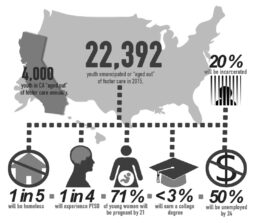
With her shoulders slumped and a scowl on her face, they barely recognize the most optimistic girl at school. She sighs as she sits down at her desk, saying, “I lost the streak.” At the expectant gaze of her concerned classmates, she reveals somberly, “It was 256 days.”
Though the above is a fictitious scenario, the reality of the frustrations regarding the loss of a streak is no joke. The “Snapstreak” is where Snapchat counts the number of consecutive days two users snapchat back and forth, and it is equated with a sacred religion among teenagers these days.
The renowned sorrow at a loss of a streak reveals how Snapchat’s addictive nature actually makes it the most harmful form of social media. Wasted time, feelings of insecurity, and falsified relationships usually associated with other forms of social media are magnified due its unparalleled accessibility — to the user’s unknown detriment.
Snapchat’s first crime is that it wastes too much time. According to SnapchatDownloads.com, over 400 million snapchats are sent per today, and over 1 billion are viewed. It’s evident that Snapchat’s independent structure successfully hooks teenagers.
Forms of media like Facebook, Instagram, or even Snapchat’s “My Story” rely on minimal interaction — posts are merely viewed and double-tapped. On these forms of media, users need to wait to for another person to post new content before they are entertained again. The unspoken Instagram rules of “not posting two days in a row” coupled with Facebook’s reservation for important life events creates periods of content stagnation that needs to be filled.
Snapchat solves this problem with personal snapchats — the true time killer. If a user already viewed all the stories on their feed, they can simply send a snapchat to any of their friends on their list and await a reply. In fact, they can send the same snapchat to multiple other users, allowing them to increase the likelihood of receiving a reply and satisfying their boredom. The accessibility of all their snapchat friends, in addition to “My Story,” creates enough new content to constantly keep users busy. Minutes are wasted on meaningless snapchats every day.
Another fault unique to Snapchat is how it creates false ideas about relationships. Back when everyone could view other people’s “best friends,” or the people they snapchatted the most, some users tried to see who was on who’s list because they claimed it revealed who was crushing on who. Though this feature currently doesn’t exist, the new hierarchy of emojis that took its place implemented a different kind of obsession.
Snapchat created a code of emojis to signal Snapchat milestones; for example, smiley faces equate a best friend. By elevating the significance of streaks and snapchat best friends, people believe their relationships are closer than they are in actuality. They mislead users by distracting them with bright, rewarding emojis; two users are best friends for two weeks, they must be in love, right?
Specifically, the fire emoji signals streaks — a separate offender. Users believe that a finite amount of days snapchatting gives their friendship merit — that their friendship is stronger because of it.
But how many of those snapchats were prompted because a user wanted to tell their friend something, and how many of them were a black screen with the word “Streak” sent seconds before the streak died?
Moreover, compared to all the other forms of social media, Snapchat breeds the most insecurity. When users check on their friends’ Stories, they feel disappointed or jealous when they aren’t invited to an outing their other friends are at. In addition, the accessibility can make these insecurities obsessive. Several users unhealthily use Stories to check up on people they want to keep tabs on — their friend, their ex, their favorite celebrity.
Finally, the greatest downfall of Snapchat’s accessibility is its effect on real life. People instantaneously pull out their phone and snap a picture right in the middle of a conversation. Yet, no one condemns this rude action.
Snapchat’s accessibility also harms real life interaction by leaving no mystery. “My Story” allows people to be constantly updated on every aspect of a person’s day; they record the explosion in chemistry, or the food they ate for lunch (and breakfast, and dinner). There is no need to ask someone how the concert was, or what they did over the weekend because every second of the experience was posted. The omnipresent power Snapchat gives diminishes the amount of amusing storytelling and the actual feeling of intimacy created by face-to-face conversation.
Snapchat is fun; the filters and streaks make interacting with peers a game-like scenario. But don’t be fooled — just like its bunny filter, Snapchat might not be as innocent as one thinks.



